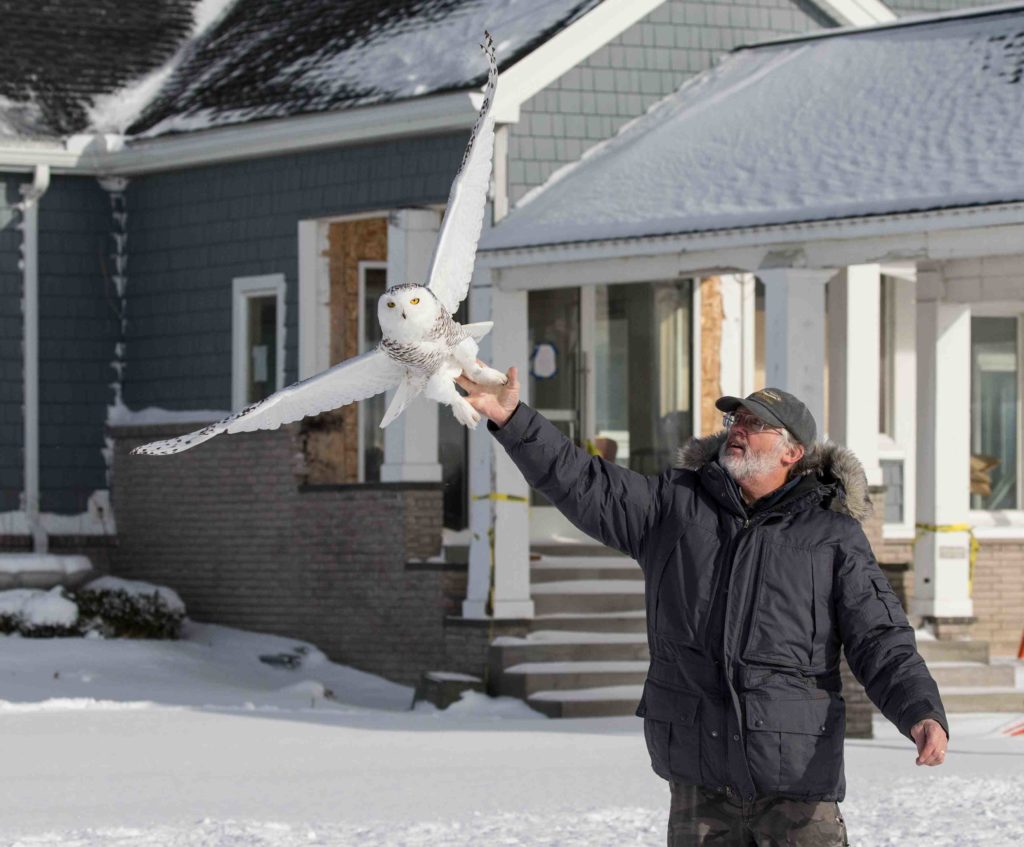
Tom McDonald of Rochester, NY, who has been studying snowy owls for more than three decades, is the first recipient of Project SNOWstorm’s lifetime achievement award. (©Aaron Winters)
It is with both deep pleasure and profound respect that we announce the selection of Tom McDonald of Rochester, New York, as the recipient of Project SNOWstorm’s first lifetime achievement award for advancing our understanding of snowy owls.
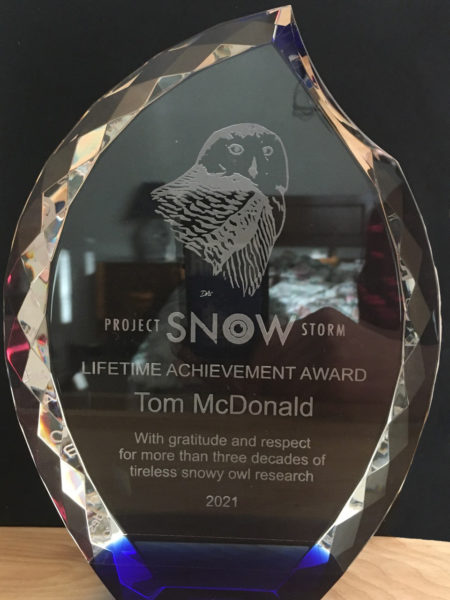
Tom’s award, inscribed (with the artist’s permission) with a snowy owl by David Allen Sibley.
Tom’s name will be familiar to anyone who has been following Project SNOWstorm. He became one of our most important collaborators in the project’s early days, but Tom’s history with snowy owl research goes back decades before that. He has been a trailblazer for more than 30 years, often working alone and largely unheralded in upstate New York and the St. Lawrence valley, banding more than 500 snowy owls and thousands of other raptors across North America, inspiring and training other banders and researchers, and sharing his love for snowy owls with countless people.
Tom was surprised with the award Saturday, March 20, during a Zoom celebration attended by more than 60 of his friends, family, and colleagues from Project SNOWstorm and the International Snowy Owl Working Group from around the world
Born in 1950 and raised in Rochester, Tom studied mechanical engineering in college and was fascinated by anything that flew, from rockets and airplanes to birds and butterflies. With a pilot’s license under his belt, and a keen love for the outdoors, he moved West in the mid-1970s, managing a warehouse for Kraft and spending his free time birding, hiking, hunting, fishing and flying. He is a born innovator,constantly refining and reimagining trap designs that were both more effective as well as safer for both the raptors he captured and lure animals he used. For example, Tom applied his engineering know-how to designing traps for researchers at the Colorado Division of Wildlife, and built a radio-controlled bow-net to catch golden eagles for Dr. Frank Craighead, one of the famous Craighead twins who studied raptors, grizzly bears and many other species in the northern Rockies.
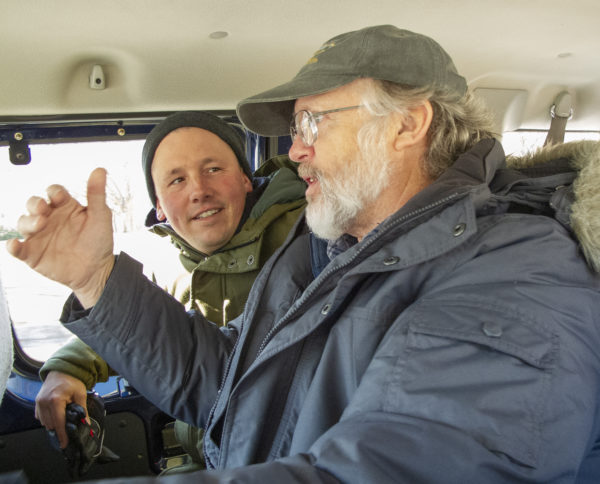
Tom McDonald, right, with Mike Blom of Alberta during the 2017 International Snowy Owl Working Group meeting in Boston. (Roar Solheim)
In 1985, Tom moved back to Rochester, where he joined Braddock Bay Raptor Research as a volunteer, cutting net lanes, designing and building hawk blinds and traps, and eventually running their Payne Beach trapping blind for many years.He encountered his first snowy owl in Rochester in the mid-1980s and, as he put it, “immediately fell in love.”
He read everything he could find about snowies in the scientific literature, but one thing he read repeatedly made no sense: That many snowy owls starved to death during irruption years. “The math failed to add up for me,” he explained several years ago. “If most of these juvenile owls starve to death, why do we still have snowy owls? Couldn’t these owls find a rodent or rabbit somewhere between the tundra and Rochester? And if they were in poor condition when they left the tundra, why fly 1,500 miles to die here? More importantly, where did they get the energy to fly that far?”
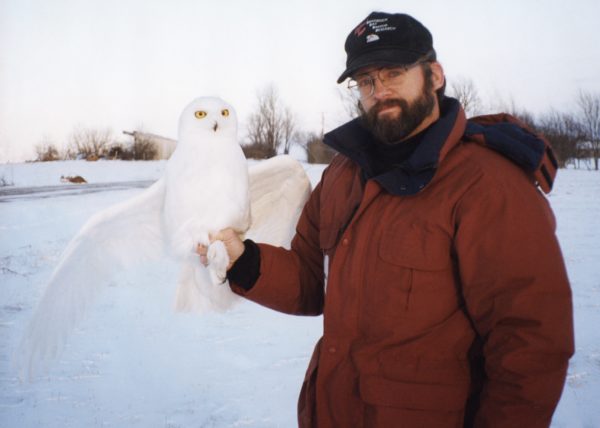
Tom with a very white adult male snowy owl. (©Tom McDonald)
So Tom started studying snowy owls himself, launching Project SnowyWatch in 1989, with advice and support from Norman Smith in Massachusetts (another long-time snowy owl researcher who was, like Tom, a founder of Project SNOWstorm). Tom designed remote-controlled bow-nets for capturing owls, banding them to track their movements and survival in upstate New York. It soon became clear to him, as it had to other researchers like Norman, that the conventional wisdom was wrong — most migrant snowy owls are in good physical condition, and many return repeatedly year after year.
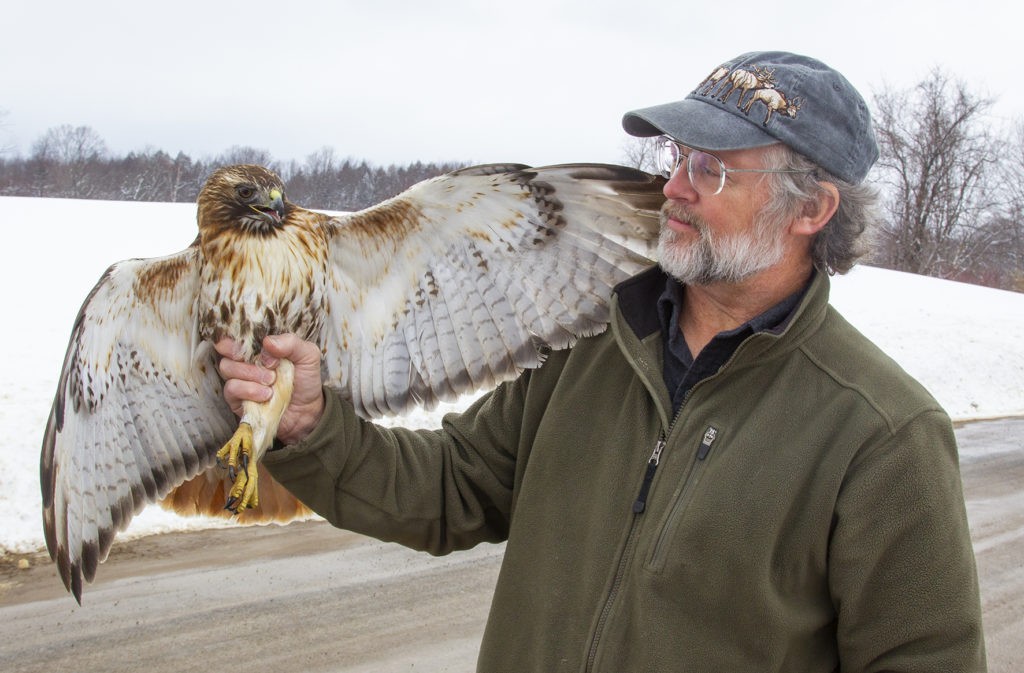
Tom McDonald has worked with more than just snowy owls — he’s banded thousands of other raptors, like this red-tailed hawk. (©Roar Solheim)
But those discoveries took time — an incredible amount of time. Tom, who was then working at a paper warehouse, changed his shift from days to evenings so he’d have more time to search for owls. He bought an economy car to stretch the funds he had for travel and fuel. Each day, he was in the field from 6 a.m. to a few hours before his shift started. Two days a week Tom covered the south shore of Lake Ontario from Rochester west to Buffalo, and another two days he’d scour the shore from Rochester east to Oswego, Fair Haven and Sodus. The fifth weekday was devoted to chasing birds outside his core area, based on tips from the public.
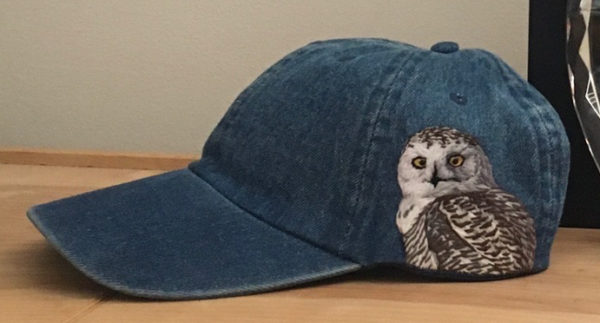
Tom is never without a hat, so part of the award was a one-of-a-kind, hand-embroidered snowy owl hat by artist Jackie Kozlowski.
On weekends he would be out the door at 3:15 a.m., heading east to Cape Vincent and points east along the St. Lawrence Seaway, arriving by daybreak when the owls would still be hunting. He drove through lake-effect blizzards and icy roads, often putting 700 or 800 miles on his car in a weekend. He searched, trapped and banded seven days a week from mid-November through late March, winter after winter — longer in irruption years.
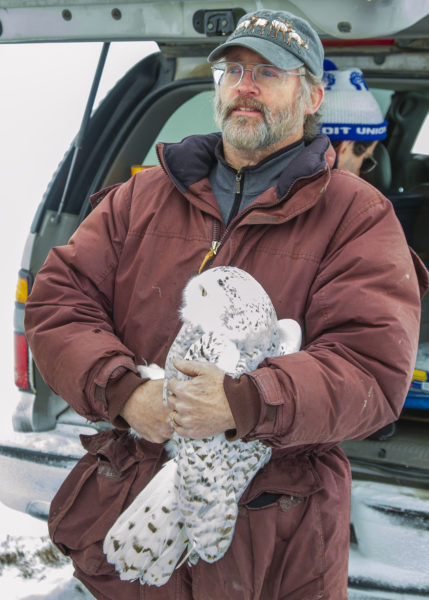
Tom McDonald with a snowy owl caught during the ISOWG meeting Saskatoon, SK, in 2017. (©Roar Solheim)
“I outfitted myself with top-of-the-line winter clothing, including boots that were comfortable down to -100F, because winters in northern New York can see temps drop to -30 to -40F,” Tom recalled. “I bought a special engine heater plug to keep my car from freezing at night on the weekends up north. On weekend sleep-overs, I closed off one bedroom of my frozen cottage at Black Lake, N.Y. I used an electric blanket to thaw the bed mattress and relied on a small portable electric heater to keep the room at 50-degree sleeping temperature.”
Over the years, Tom put almost half a million miles on his car, and banded more than 500 owls (not including recaptures), averaging about 900 miles per owl. He invested something more than 15,000 hours in the project, and tens of thousands of dollars out of his own pocket, but it was worth it. He befriended many of the property owners in his research areas, working in their heated garages or kitchens when the weather outside was awful, and allowing their kids to help him release snowy owls he’d banded — creating in the process an army of helpers who kept an eye on snowy owl numbers and movements.
Tom is an active member of the International Snowy Owl Working Group, respected by colleagues from Canada, the U.S., Europe and Russia. His contributions to the science of snowy owls stretch far beyond New York. For example, Tom supplied photographs of the open wings or more than 100 of his snowy owls to Norwegian researcher Dr. Roar Solheim, who used them to decipher the feather replacement pattern over time in snowy owls, and thus allow for far more accurate assessments of a captured bird’s age. Solheim describes Tom as “one of the most skilled snowy owl banders in North America.”
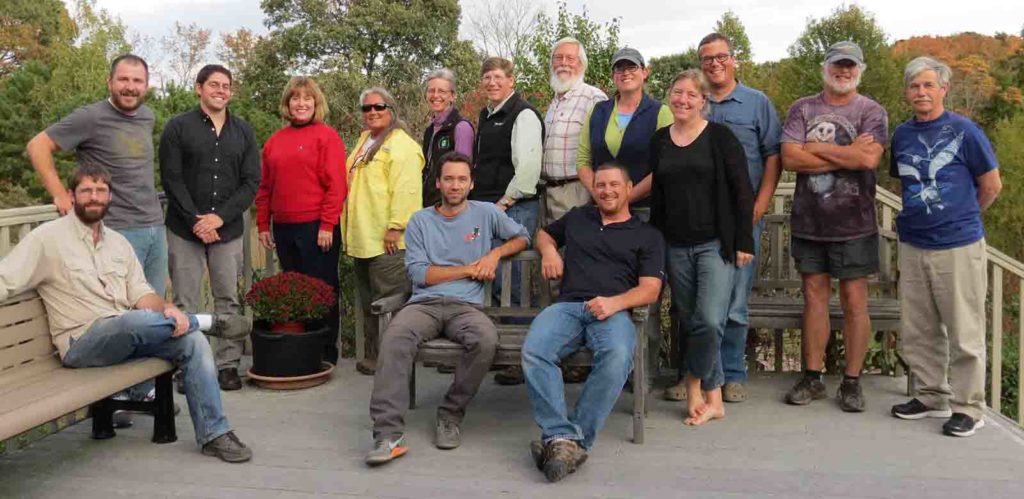
Tom, second from right, with the Project SNOWstorm team, in Cape May, NJ.
“Tom’s many skills, talents and great sense of humor have never ceased to amaze me over the years,” Norman Smith said. “He is a great friend and dedicated, long-term researcher who sets an example for future generations to follow.”
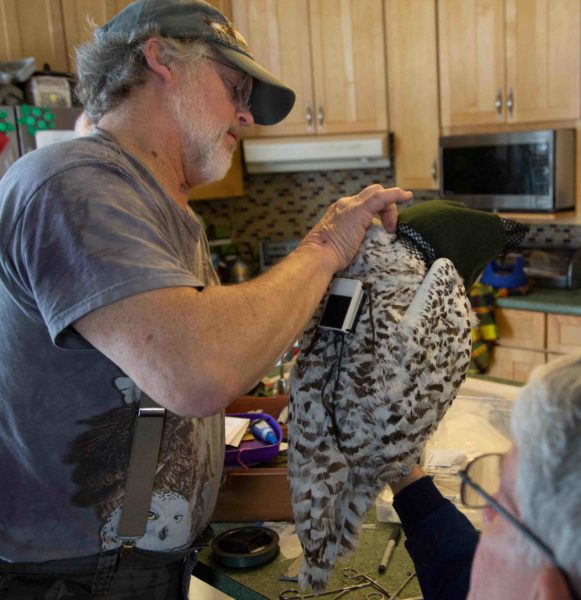
Tom fitting a transmitter harness on Orleans, one of 18 snowies he’s tagged for Project SNOWstorm.
Tom’s contributions to Project SNOWstorm have been wide and varied. Working most recently with his assistant, bander Melissa Mance-Coniglio, Tom has tagged 18 snowy owls for Project SNOWstorm in New York and Ontario, including some individuals like Hardscrabble and Otter that provided especially large datasets stretching across years. He has been generous with his extraordinary depth of experience, giving his advice freely, and sharing his ever-more effective and safe trap designs and trapping approaches with other researchers. And it was because, years ago, Tom energized a teenager named Mike Lanzone about raptors and banding that Mike became a golden eagle biologist and started a company to make GPS/GSM transmitters to track them. Versions of those transmitters, made by Mike’s company, Cellular Tracking Technologies, are what we use to follow our snowy owls.
For all these reasons and many more, we are privileged to honor Tom McDonald with Project SNOWstorm’s first lifetime achievement award.


22 Comments on “Tom McDonald Receives Project SNOWstorm’s Lifetime Achievement Award”
Tom has a stunningly impressive resume of individual research; this award (including the hat!) is a well-deserved honor.
What a wonderful leader and success story!
Thanks and congratulations, Tom!
Congratulations! Well deserved!!
Awesome contributions!
Wow, what a gifted and dedicated citizen scientist! The birding world is forever in your debt, Tom. Congratulations on an award very well deserved!
I had the privilege of watching Tom and Melissa Mance capture a Snowy at the East Spit on Braddock Bay a few years ago. It was so amazing to watch!!! I believe the Snowy was named Hiton. Congratulations Tom!!! What an incredible resume and award.
“What a wonderful tribute to Tom. He certainly deserves this award. I am so pleased to read about all his accomplishments and give a shout out and congratulations to a great guy/! Tommy,, I am so happy for you!!
Sending lots of love and laughter your way.
Congratulations Tom! We admire your dedication and contributions to Snowy Owl knowledge and conservation.
Congratulations Tom, May God bless you and give you grace and continue to protect you! I am honored to be your brother!
Well deserved! Congratulations!
Just simply stunning life’s work Tom. Well done. Really well done. I guess it’s been a long time since we played football on Spencer Road. Would love to catch up with you again one of these days.
Congratulations Tom.
On your great accomplishment, Carl is proud to be one of your OLD friends,
Keep up your great work.
What an astounding resume of knowledge and dedication not to mention sacrifice. When are you writing your book Tom? What a cool award to display and be proud of. Congratulations
Awesome! Well done and thank you all.
Congratulations, Tom! A well deserved award for a really good researcher and a Great Person!!
I am forever thankful that we have people like Tom who are consistently willing to go that extra mile in the pursuit of knowledge, and think/work creatively to improve things like traps and techniques for the benefit of all.
Thank you, Tom, for all you do and all you have done.
Congratulations Tom!!!! A well deserved award! Impressive dedication to research and conservation efforts of Snowy Owls and other raptors . We had the privilege of meeting Tom when he was in our area to retrap a snowy owl a few years ago, he’s a great guy and shared his knowledge and passion for these amazing birds. Thanks for all you do Tom.
Great work Tom! Wish there were more people like you out there!
Bravo, Tom !
Tom McDonald is well deserving of the present award and many more. His dedication to the studing of the Snowy Owl is unmatched. With the support of his lovely wife he has continued on. What some don’t know Tom has done his research while battling cancer also. Not an easy task for sure. Congratulations Tom.
All of us at Project SNOWstorm couldn’t agree more.
Congrats Tom! Glad you were given this award. You well deserve it. So many early mornings and cold weather. And the ‘Ghost’! What a day that was….glad to have been a part of it. One of my favorite pictures too.